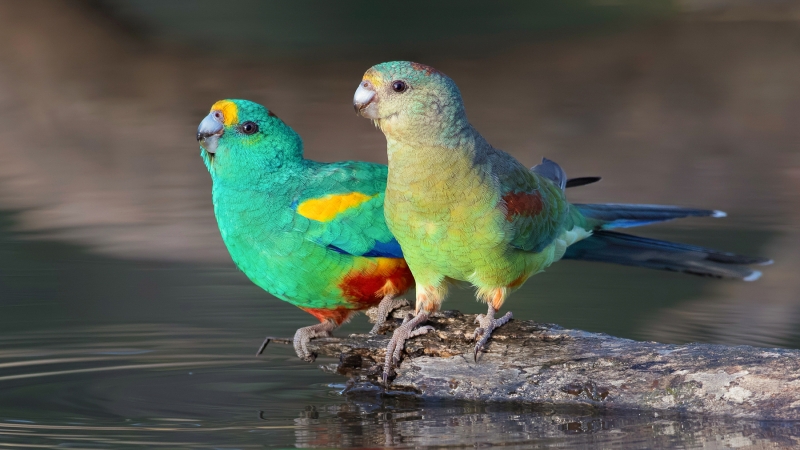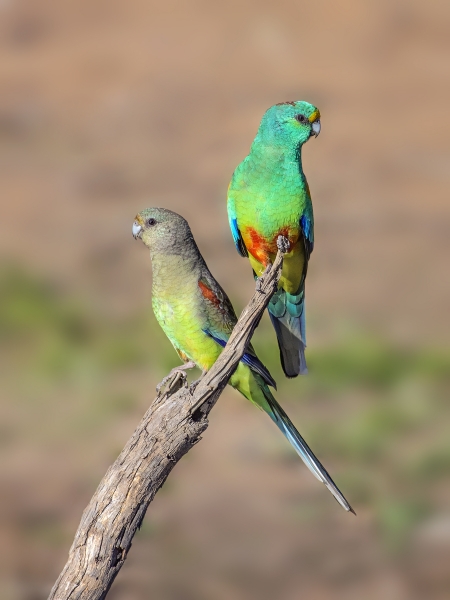Photographing pairs of birds has its technical and aesthetic challenges which the competition organizers no doubt had in mind when this theme was chosen. Ideally, the two birds should be in focus but this is often not easy to arrange especially as many bird photographs are opportunistic captures. Just getting a pair in the frame can require a great deal of planning, patience and good luck. When it is possible to get only one of the birds in focus, there is a strong preference for the bird closest to the camera to be the one in focus. I don’t know the reason for this preference, but it is agreed by critics and photographers that it results in a more pleasing composition.
At the Advanced Level we expect to see images with no obvious technical issues but there were a few with unacceptable digital noise or with neither bird acceptably sharp. Lighting and colour management were generally good with acceptable rendering of sky and birds in most cases. Many professional photographers exaggerate the colours, ironically of birds that are already brightly coloured, so it was pleasing to see most of the entrants resisted this temptation.
Winner: Mulga Parrots, by Bill Harding (Image ID 36593)
There were some stunning images in this competition making it very difficult to choose the images for commendation but there was no doubt about the stand-out winner. This is a great capture with so many ingredients all coming together in mutual support. The birds are in sharp focus, they are in a spotlight of early-morning light surrounded by soft shadows, the colours are right, with a pleasing head angle, and they are making strong eye contact with the viewer. The composition is beautifully crafted with the birds nicely placed in the frame, perhaps a bit tight, but still very effective. The interplay of light and dark water, the ripples and the perch are all understated, allowing the birds to radiate avian splendour. The photographer comments on the beneficial effect of the soft light and the absence of bright bands of light reflected off the ripples is apposite. Sometimes the light reflected off ripples can add to the composition but in this case the image is better without them. This is a wonderful picture and worthy winner.
Highly Commended: Australian Wood Duck family portrait, by Doug Castle (Image ID 36851)
This scene is so precisely choreographed it could have been taken in a portrait photographer’s studio. There are nine birds in the frame, seven ducklings and a pair of adults, and what is remarkable is that they are all looking at the photographer and all in sharp focus. The composition is pleasing with the birds perfectly placed in the frame, the alert parents standing behind, the ducklings at their feet, all embraced by the surrounding vegetation and water’s edge. The muted tones of the surroundings work in harmony with the birds to produce a classic family portrait. Even the shadows seem to be carefully arranged to add something to the composition rather than the usual negative impact. Full marks to the photographer for seeing the potential in front of his camera when others would walk past the scene.
Commended: Great Crested Grebes, by Stephen Garth (Image ID 36662)
What makes this image of a pair of somnolent Great Crested Grebes special is the light. The birds have been captured in a soft spotlight penetrating through the surrounding vegetation making them stand out from the shade. The birds are positioned back in the frame so that the light scattered forward has produced a fuzzy reflection which helps focus attention. The auto-suggestion created by the snoozing birds, soft light and sombre tones is enough to create a feeling of tranquillity and quietness. I was moved to think in whispers lest I disturb the birds. The impact this picture has on one’s emotions is a feeling of gentleness in an increasingly harsh and noisy world.
Commended: Australasian Gannets, by Doug Castle (Image ID 36854)
This image is a tender moment well captured. Photographers usually rely on eye-contact with birds to make the emotional connection. Here is an example without eye-contact with the viewer but the emotional connection is still there. It works because the loving couple are renewing their bonds oblivious to the voyeur snapping their picture. The scene is like the exchange of vows in a wedding ceremony, the bride and groom are expected to be looking into one another’s eyes and not at the camera. Technically fine with the whites well managed, there is a lot to like about this image.
Commended: Mulga Parrots, by Bill Harding (Image ID 36538)
Some people are critical of the ‘bird on a stick’ composition but they have a place. We need photographers who can execute this style well for reference images and record shots in the BLP image library. To catch the eye of a critical audience this type of image must be technically perfect, as in this example. Pulling off a picture like this with both male and female in perfect light and focus is no mean feat. The choice of perch and the position of the birds with shadows across their tails is not ideal but not too distracting. The ideal situation is to have the subject on the light side of the perch. The image has a soft background with tones that complement the birds and allows them to stand out as the focus of attention. Almost the perfect record shot, well done.




